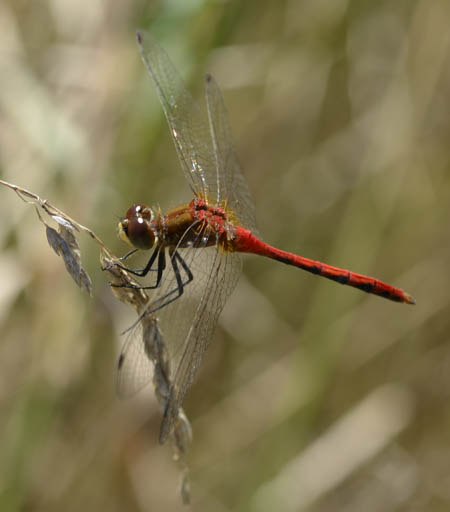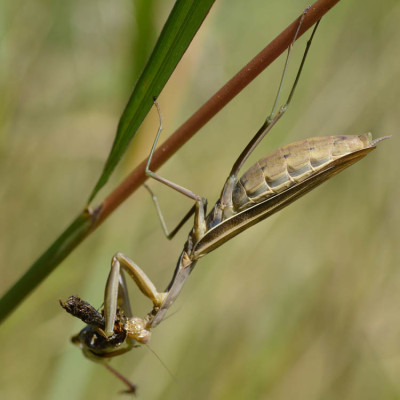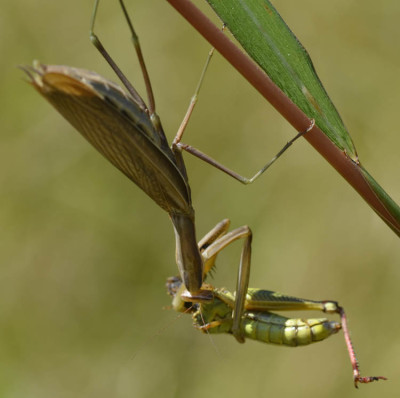While out enjoying the migration of the Green Darners at Lakeside Park in Mississauga in September, I spent some time taking photos of various Skippers and Dragonflies. I soon learned to slow down and scan the tall grasses, asters, burdock and goldenrod plants around me before moving. Otherwise I would see a lovely Twelve-Spotted Skimmer or cherry coloured Meadowhawk just a little too late to capture a photo. So when I saw a large brown lump on a stem I paused to look more closely: and discovered a Praying Mantis enjoying a haunch of grasshopper.
[If you’re squeamish about such things, you may prefer not to read on as there are a few photos.]
Praying Mantis or Preying Mantis?
One of the first things I had to confirm before writing this article is whether these ‘stick and leaf’ shaped insects are called “praying” or “preying” mantises. They certainly do “prey” on other insects. However, when at rest, their arms do fold up in a sort-of “prayerful” way. I discovered that one type, the European Mantis religiosa, is specifically called the Praying Mantis but that many people use the same name for all types of Mantises.
Are Praying Mantis Native Insects in Canada?
The mantis I was watching, a Mantis religiosa, is not native to Canada. There is one native mantis, but it’s only found out west in the southern Okanagan Valley, according to the Canadian Encyclopedia. The mantises in Ontario are a type that was accidentally introduced to North America over 100 years ago from Europe. They are also sold in North America as “natural” pest controls, in the same way that some types of ladybugs are sold. Praying Mantises are also popular pets.
What Was My Praying Mantis Doing?
My mantis was eating what was left of a large grasshopper. Unlike many predators, mantises eat just about everything on their prey. So while a Kestrel would likely strip off and drop the skinny ends of the grasshoppers legs, the mantis was eating it all.
Given the very wide abdomen on my mantis, I suspect it was a female and that it was carrying eggs. Most “wild” mantises in Ontario lay their eggs in a frothy sac in fall. The sac quickly hardens into a papery mass. The young mantises hatch in the following spring.
Do Praying Mantises Fly?
While walking in the long grasses looking at the dragonflies, I startled many grasshoppers that flew a few yards before hiding again. I also twice startled something that had very large, pale tan translucent wings. After finding the mantis, I was left wondering do Praying Mantises fly? And if so, what do their wings look like?
First, I was able to confirm that Praying Mantises can fly. I was not able to find a photo or a video, though, of a European Mantis in flight, so I’m not sure what the wings look like. If I find out more later, I’ll update this article.
UPDATE: Experts at BugGuide.net provided these useful comments about flying mantises:
J. Stanard said, “This is an adult, gravid female. Hindwing color is dependent on species; M. religiosa’s are clear.”
and
P. Dennehy said, “Certainly a gravid female. Mantids generally have opaque forewings, but the hindwings, which are larger and used for flight, are mostly transparent or translucent. You can’t see the hindwings when they’re at rest, but when they fly past, they do give the impression of something with transparent wings. The only thing that looks like a mantis in flight if it’s only seen briefly is a katydid.”
Thanks to both of them for their helpful comments!
The Moral of the Story
I guess the moral of this story is that it pays to slow down and look closely if you want to see more. If I hadn’t been paying close attention, I would never have noticed this “dead leaf” was much more than that.
Related Reading
- European Mantis
- Hundreds of Dragonflies Are Startling School Children near Toronto this September
- Female Northern Walkingstick in Riverwood Park, Mississauga
Join In
Have you stumbled upon an unexpected close-up look at any interesting species? Please share your experiences with a comment.




have seen one on top of 23 story building by cooling tower
They can fly so they can show up in odd places. Thanks for sharing your sighting: 23 storeys is impressive!
I saw pale greenish gossamer wings fluttering slowly – a short distance of a couple of feet; almost a dragonfly in appearance. It settled on a plant stem and then I recognized it as a praying mantis. This is the first time that I have seen one fly and it was fascinating! They have just appeared this past week in our area, Honey Harbour, Canada.
I was mystified the first time I saw one flying and I still love to see them. Thanks for sharing your wonderful sighting!
I have a Praying Mantis on my balcony on the wall near the ceiling. He/She has been here since early this afternoon. I am worried that his wing is injured. Find me on Facebook and I will send you videos and photos. I live in Mississauga . Find me on Facebook because my email is not working
I have read that female Mantises often cannot fly especially when they are very full of eggs. So your Mantis may be totally fine. Also at this time of year, the females look for a spot to lay their eggs, then unfortunately they die. This is normal for them, not something unusual.
If you want, you can easily catch the mantis and carry it back down to a tree trunk or garden and release it. If you move carefully and preferably wear gloves it is unlikely you will get a bite.
What does a male preying mantis look like?
If you look through the images on bugguide.net many of them indicate if they are male, like this one:
https://bugguide.net/node/view/1927663/bgimage
or female.
Generally if it is big and very “fat” looking it is a female.
The Praying Mantis that has been on my balcony all day and evening is brown with a green belly. He is walking but not flying. I am worried that his wing is broken or he is injured. I have some honey on a lid for him but he is too high up for me to offer it to him. I don’t know if you would be willing to come and rescue him but I am worried about the little guy. Please help him or give me some advice,. My email is not working but you can find me on Facebook Messenger